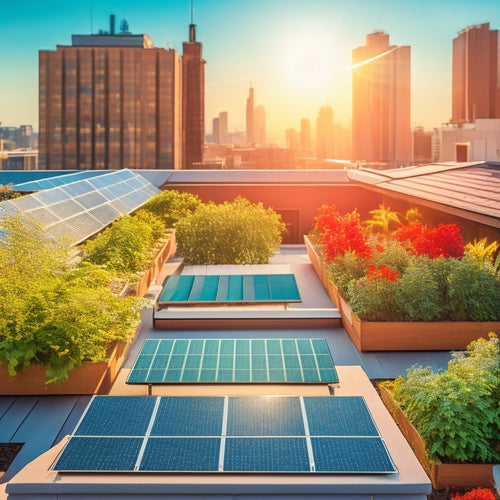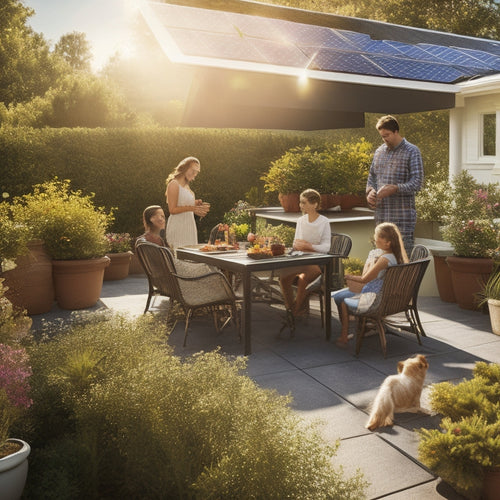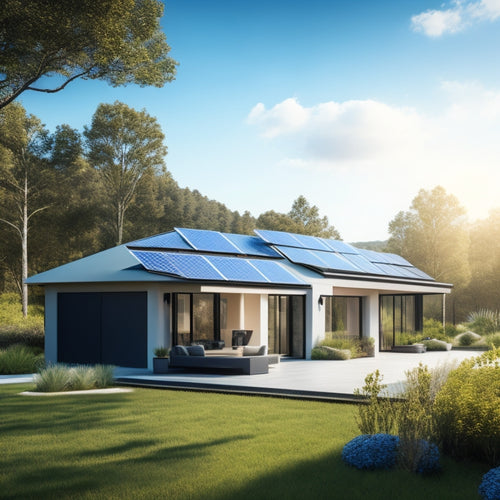
What to Expect From a Commercial Solar Power Installation
Share
When you commence a commercial solar power installation, you'll undergo an extensive process involving site assessment and preparation, system design and planning, and permitting, which sets the stage for a successful installation. The installation process itself will involve a skilled team managing labor, equipment, and timelines to guarantee a seamless integration with the grid. Post-installation, you'll need to evaluate ongoing maintenance and support, performance monitoring, and quality assurance to maximize energy production and reduce downtime. As you traverse this complex process, you'll uncover the details of commercial solar power installation and the key considerations that drive its success.
Key Takeaways
- A comprehensive site assessment is conducted to evaluate sunlight availability, accessibility, and environmental impact before installation.
- A customized system design is developed to meet specific energy objectives, considering shading, roof orientation, and available space.
- The installation process involves panel installation, electrical connections, and testing, with expert project management to ensure timely completion.
- Ongoing maintenance and support are crucial to ensure peak operational efficiency, with continuous monitoring, scheduled inspections, and repair options.
- System performance monitoring and optimization are essential to maximize energy production, with real-time data analysis and predictive maintenance.
Site Assessment and Evaluation
During the initial stages of commercial solar power installation, a detailed site assessment and evaluation are critical to determine the viability of the project.
You'll need to conduct a solar resource assessment to measure the amount of sunlight your location receives, making certain it's sufficient to generate the required power. A site accessibility evaluation will also be necessary to identify any potential obstacles, such as limited space or difficult terrain, that could impact the installation process.
Additionally, an environmental impact analysis will assess the project's potential effects on the surrounding ecosystem. A structural integrity review will evaluate the condition of your building or infrastructure to verify it can support the weight and stress of the solar panels.
Shading analysis will identify any potential shading issues that could reduce energy output. Utility interconnection assessment, existing infrastructure evaluation, regulatory compliance check, financial feasibility analysis, and safety risk assessment will also be performed to guarantee a smooth and successful installation.
System Design and Planning
You'll use the site assessment results to inform your system design and planning, ensuring that your energy efficiency goals are aligned with the installation's capabilities.
You'll need to take into account your site's specific needs, such as shading, roof orientation, and available space, to determine the ideal system size and configuration.
Site Assessment Needs
How can you guarantee a commercial solar power installation meets your energy needs and budget? A thorough site assessment is essential to guarantee a successful project. This involves evaluating your site's solar potential, identifying potential obstacles, and determining the ideal system design.
During the assessment, your solar installer will consider various solar site considerations, including:
| Site Factor | Impact on Solar Installation |
| Shading | Reduces energy output, affects system design |
| Roof size and condition | Determines system size, installation method |
| Orientation and tilt | Affects energy output, system performance |
| Environmental impact | Assesses potential impact on local ecosystem |
Energy Efficiency Goals
With a thorough site assessment complete, your solar installer can now focus on designing a system that meets your energy efficiency goals.
This involves understanding your organization's specific needs and objectives, such as reducing your carbon footprint, increasing energy independence, and implementing sustainability practices.
Your installer will work with you to identify areas where energy efficiency can be improved, and develop a customized plan to achieve your goals.
System Sizing Options
Three key factors determine the ideal system size for your commercial solar power installation: energy load, available roof or land area, and local building codes and regulations.
You need to take into account how much energy your business consumes and how much space is available for the solar panels. Additionally, local building codes and regulations may impose restrictions on the system size.
When sizing your solar power system, you'll need to take into account the following solar capacity considerations:
-
Peak sun hours: The amount of solar energy your location receives daily.
-
Energy usage patterns: How much energy your business uses during peak and off-peak hours.
-
System losses: Energy lost due to inefficiencies in the system, such as inverter losses and wiring losses.
Inverter selection criteria are also significant in determining the ideal system size.
You'll need to choose an inverter that can handle the maximum power output of your solar panels while ensuring efficient energy conversion. A correctly sized system will maximize your energy savings and reduce your carbon footprint.
Permitting and Approvals Process
Your commercial solar power installation project's success hinges on steering through the often-complex permitting and approvals process. This process involves obtaining necessary permits and approvals from local authorities, utility companies, and other regulatory bodies.
You'll need to comply with regulatory requirements, such as building codes, electrical codes, and environmental regulations. Your solar installer will typically handle the application process, ensuring that all necessary documents and plans are submitted on time.
It's crucial to understand the application timelines, as delays can impact your project's schedule and budget. Timely submission of applications and compliance with regulatory requirements can help minimize delays.
Your installer will also coordinate with local authorities to schedule inspections and obtain final approval. Be prepared to provide additional information or clarification as needed during the permitting process.
Installation Timeline and Phases
Once you've cleared the permitting and approvals process, it's time to focus on the installation timeline and phases. This is where your project management skills will be put to the test, as you'll need to coordinate with your installation team, suppliers, and local authorities to guarantee a smooth and timely installation.
The installation process typically consists of several phases, including:
-
Site preparation: This involves clearing the area, removing debris, and preparing the ground for the solar panel installation.
-
Panel installation: This is the most labor-intensive phase, where the solar panels are installed on the mounting system.
-
Electrical connections and testing: The final phase involves connecting the panels to the inverter and testing the system to verify it's functioning correctly.
During this process, you may encounter installation challenges such as weather delays, equipment shortages, or unexpected site issues.
A well-planned project management strategy can help mitigate these risks and guarantee that your commercial solar power installation is completed on time and within budget.
Equipment and Material Quality
With the installation timeline and phases well underway, attention turns to the vital aspect of equipment and material quality, which can greatly impact the performance and longevity of your commercial solar power installation.
You'll want to verify that your installation features high-quality solar panels that utilize the latest panel technology advancements, providing peak energy output and efficiency. Inverters, too, play a significant role, and you should opt for models with high inverter efficiency improvements to minimize energy losses.
The durability of solar materials is also essential, as it directly affects the system's lifespan and overall performance. Be sure to inquire about sustainable sourcing practices and environmentally responsible manufacturing processes.
When evaluating equipment options, consider installation cost considerations, energy storage options, and warranty and lifespan guarantees. Additionally, assess the environmental impact of the equipment and materials, as well as their grid integration challenges.
Installation Team and Labor
Skill is essential when it comes to guaranteeing a seamless and efficient commercial solar power installation. The installation team's proficiency and labor cost considerations are significant factors in determining the success of your project. You want a team that can maneuver complex rooftops, handle heavy equipment, and work efficiently to minimize downtime.
A well-coordinated installation team coordination is essential. You should expect a team that:
- Has extensive experience in commercial solar installations
- Possesses the necessary licenses and certifications
- Has a proven track record of completing projects on time and within budget
Labor cost considerations are also critical. You'll want to guarantee that the installation team is adequately staffed to complete the project efficiently, minimizing labor costs without compromising quality.
Be wary of companies that cut corners by under-staffing or hiring inexperienced laborers. This can lead to costly rework, delayed project timelines, and even safety hazards.
Connection to the Grid
After guaranteeing a seamless installation, your commercial solar power system needs to be connected to the grid to feed excess energy back into the electrical infrastructure. This connection enables you to sell excess energy back to the utility company and offset your energy costs. To guarantee a smooth interconnection, your installation team will work closely with the utility company to meet grid interconnection standards.
| Utility Partnership Benefits | Grid Interconnection Standards | Your Benefits |
|---|---|---|
| Net metering agreements | IEEE 1547 standard | Reduced energy bills |
| Real-time energy monitoring | UL 1741 standard | Increased energy independence |
| Priority customer support | NEC 690 standard | Enhanced system reliability |
| Energy storage integration | CA Rule 21 standard | Improved system performance |
| Renewable energy credits | Federal tax incentives | Increased property value |
Ongoing Maintenance and Support
You'll want to guarantee your commercial solar power installation operates at peak efficiency, which requires ongoing maintenance and support.
This involves system performance monitoring to identify potential issues, scheduled inspections to prevent problems, and repair and replacement options to minimize downtime.
System Performance Monitoring
Your commercial solar power installation's performance monitoring system plays an essential role in guaranteeing ideal energy output, identifying potential issues, and facilitating prompt maintenance.
This system provides you with real-time monitoring capabilities, allowing you to track your energy production and detect any deviations from expected performance metrics. Through data analysis, you'll be able to recognize areas for improvement, optimize system reliability, and maximize financial savings.
Here are three key benefits of a performance monitoring system:
-
Enhanced operational efficiency: Real-time monitoring enables you to respond quickly to system issues, minimizing downtime and reducing the risk of lost energy production.
-
Data-driven decision making: Performance benchmarking and data analysis provide significant understandings to inform maintenance, repair, and upgrade decisions.
-
Maximized energy production: By identifying and addressing performance issues promptly, you can guarantee your system operates at peak efficiency, generating the maximum amount of energy and financial savings possible.
Scheduled Inspections Needed
Regularly scheduling inspections for your commercial solar power installation is vital to maintaining its best performance and longevity.
You'll want to confirm that your system is running at peak levels, and inspections are essential to achieving that. The inspection frequency will depend on various factors, including the size and complexity of your system, as well as compliance requirements and regulatory guidelines.
During these scheduled maintenance inspections, your installer will check your system's performance standards, verifying that it meets quality assurance benchmarks.
They'll also review safety protocols to identify any potential hazards or risks. Inspection checklists will be used to verify that all components are functioning correctly, and any issues will be addressed promptly.
Repair and Replacement Options
Many commercial solar power installations require ongoing maintenance and support to guarantee peak performance and longevity. As a commercial solar power installation owner, you'll want to be aware of the repair and replacement options available to you.
When it comes to repair and replacement, you should consider the following:
-
Warranty options: Understand the terms of your warranty, including what's covered and for how long. This will help you plan for potential repair costs.
-
Maintenance contracts: Look into maintenance contracts that offer regular inspections, troubleshooting services, and priority repair scheduling.
-
Upgrade paths: Consider upgrade paths for outdated or underperforming components, making sure your system remains efficient and effective.
Additionally, be aware of replacement timelines, which can vary depending on the type of equipment and manufacturer.
It's crucial to have a clear understanding of the process and associated costs to minimize downtime and maximize energy production.
Monitoring and Performance Tracking
The monitoring and performance tracking system is an essential component of a commercial solar power installation, providing real-time data on the system's energy output, identifying potential issues, and enabling prompt corrective actions. This system allows you to track your energy production, optimize performance, and receive system alerts when issues arise. With real-time analytics, you can monitor your system's performance remotely, identifying areas for improvement and making data-driven decisions.
| Feature | Description | Benefit |
|---|---|---|
| Real-time Analytics | Provides instant data on system performance | Enables prompt issue identification and resolution |
| Performance Optimization | Analyzes data to identify areas for improvement | Increases energy production and reduces downtime |
| Data Visualization | Presents complex data in a clear, graphical format | Facilitates easy understanding and decision-making |
| Predictive Maintenance | Schedules maintenance based on system performance data | Reduces downtime and extends system lifespan |
Frequently Asked Questions
Can I Install Solar Panels on My Roof With Existing Skylights?
You'll need to assess skylight considerations, ensuring they won't obstruct solar panels, and evaluate your roof structure's integrity to support the added weight, then consult with an expert to determine the feasibility of a successful installation.
Will Solar Panels Void My Roof's Warranty?
As you commence on this eco-friendly expedition, you wonder if solar panels will void your roof's warranty, leaving you exposed. Rest assured, you're not alone; most manufacturers won't void the warranty if installed correctly, considering roof warranty implications and installation impact considerations.
How Do I Clean My Solar Panels to Maintain Efficiency?
You'll maintain your solar panel's efficiency by adopting a regular cleaning schedule, using gentle cleaning techniques like soft-bristled brushes and distilled water to remove debris, ensuring maximum energy utilization through diligent solar panel maintenance.
Can I Add More Solar Panels to My System Later?
As you traverse the solar terrain, you're not stuck in one place - you can expand your solar panel fleet like adding Puzzle pieces, increasing system capacity to meet growing energy demands, and releasing more power and savings for your business.
Are There Any Solar Panel Recycling Programs Available?
You'll find solar panel recycling programs emerging, focusing on responsible solar panel disposal. Manufacturers and industry leaders are driving recycling initiatives, ensuring a sustainable future for solar energy, and you'll benefit from their eco-friendly efforts.
Conclusion
Congratulations, you've made it to the end of this thrilling expedition! By now, you're an expert on what to expect from a commercial solar power installation. You've survived the site assessment, system design, permitting, installation, and connection to the grid. You've even got a team for ongoing maintenance and support (because, let's face it, you'll need it). So, go ahead and bask in the glory of renewable energy – but don't get too comfortable, you've still got monitoring and performance tracking to worry about.
Related Posts
-

Solar System Installation Rebates and Tax Credits
Solar system installations offer beneficial rebates and tax credits that greatly cut your initial costs. You can bene...
-

Long-Term Cost Savings With Solar Panels
Investing in solar panels offers substantial long-term savings on energy costs. You'll benefit from federal tax credi...
-

Eco-Friendly Energy Storage Systems for Houses
Eco-friendly energy storage systems for your house let you capture and use renewable energy efficiently. You can choo...


